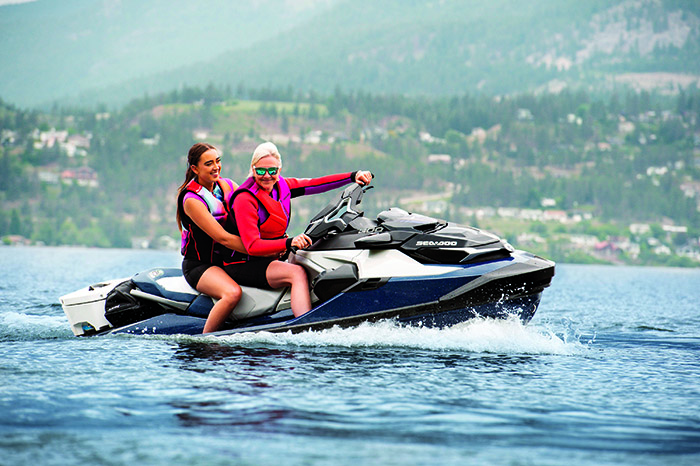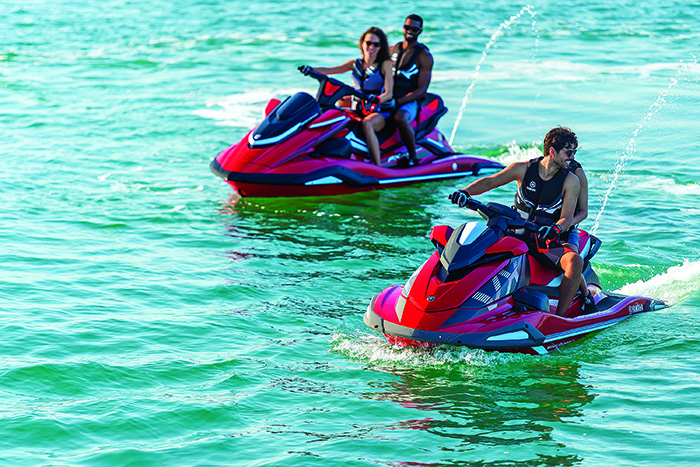Advertisement
Follow these 9 essential safety tips before throttling up on your first personal watercraft drive

Photo: Sea Doo
We’re at the end of summer now, and you’ve been watching folks having a good time riding personal watercraft (PWCs) all season. It looks like fun, but while boats and PWCs are both vessels, they’re very different watercraft. Whether you’re pondering buying one over the winter for next season or anxious about sea trialing one this season, there are a handful of PWC-specific safety considerations to make your time behind the handlebars safe and enjoyable.
Modern PWCs offer an adrenaline rush quite different from even a hard-banking boat, and enhancements like idle steering and brakes make them easier and safer to handle compared to earlier models. But if you’re new to the jet-engine life, here’s what you need to know to stay safe and have fun.
1. PFDs for PWCs
Whether borrowing a life jacket or using your own, be sure to wear a U.S. Coast Guard-approved life jacket designed specifically for PWC or watersports use. Also make sure it fits correctly – meaning snugly. If you end up in the water (and that’s part of the fun) a properly fitting, fully zipped (or buckled) life jacket helps keep your head above water. It’s also the law.
2. Lanyard First
Federal law now requires the operator of a power vessel less than 26 feet to securely attach the emergency engine cut-off lanyard to the driver. This includes PWCs. In the event you fall off the watercraft, the disengaged lanyard switch will automatically shut off the engine, allowing you to safely reboard and continue your ride. Ensure the lanyard is securely attached to your life jacket or wrist and is clear of obstacles. Avoid wrapping the lanyard around the handlebars, cup holders, or fishing rods so it can cleanly disengage if needed.
3. A Clear Runway
Part of the allure of PWCs is their exhilarating power and instant acceleration out of the hole – much faster than any boat you’ve been on. Most PWCs are paired with powerful jet drives, with some models capable of covering more than 100 feet within seconds of takeoff. This acceleration can catch new users by surprise. Before you throttle up, be sure you have a good grip and an obstruction-free path ahead. Also, be courteous to those around you, which includes controlling speed, noise, and wake, and making sure you never operate anywhere near anchored or moored boats, or swimmers.
4. Watch Your Back
Jet drives work by intaking water from below the hull and propelling it rearward, compressing it to generate a powerful stream of water that provides rapid propulsion. PWCs generally produce about 1,000 pounds of thrust at acceleration. For this reason, ensure no people or pets are behind the watercraft before you accelerate. The powerful force of the jet blast is capable of severe bodily harm. Always be sure that any passengers are safely seated and holding on and the water behind the watercraft is clear before taking off.
Am I covered?
Under a typical GEICO insurance policy, PWC coverage is the same as for a boat and includes the insured, their family, and “any other person operating an insured boat with your direct and prior permission and without compensation.” However, BoatU.S. recommends caution (and consideration about your potential personal liability outside of insurance coverage) when considering lending your vessel. — RICH ARMSTRONG

The back end of a PWC can be dangerous because its jet pumps provide powerful thrust. Photo left: BRP, Photo right: Yamaha Watercraft Group
5. Familiarize Yourself With PWC ‘Braking’
While PWCs of the past often had no braking capabilities – there was always slight forward momentum due to water flowing continuously through the jet – most modern PWC manufacturers now offer some type of braking system for making relatively quick emergency stops from speed. Sea-Doo introduced the feature with its iBR (Intelligent Brake & Reverse) system in 2009. Yamaha’s RiDE Dual Throttle Control hit the market in 2015, and Kawasaki’s Smart Reverse system debuted last year. All are activated by a trigger or lever on the handlebars. Sea-Doo claims its iBR system allows a watercraft traveling at 50 mph to stop 100 feet sooner than a model without the braking feature. The feature is also a big help for docking.
6. Depth Matters
While the average draft of a PWC is only 10- to 12 inches, they’re not designed to run in shallow water. That’s because, instead of propellers, PWCs have impellers, which suck in then expel water for propulsion. The intake grates are located on the bottom of the craft, making them prone to sucking up objects from the bottom like stones, sand, sea grass, or trash. Because of this risk, manufacturers recommend against operating PWCs in water shallower than 3 feet.
Tip
7. Keep Your Distance
Collisions with vessels, mainly with other PWCs, is the No. 1 cause of PWC accidents. It should go without saying, but the fun and excitement of being so connected to the water can lead to some unsafe decisions in the moment. While playing in boat wakes, engaging in “spray fights,” and jumping waves may seem innocuous, this kind of reckless riding is what leads to mishaps and irritates other boaters. Plus, doing so is illegal on some bodies of water. Be respectful of other vessels and operate as if you were behind the wheel of your boat to ensure everybody has an epic day on the water. A good rule to remember: If you’re 100 feet away from everything, you won’t hit anything. That includes wake damage, so slow way down within 100 feet of shoreline, docks, or anchored boats.
8. Stay Focused
PWC storage compartments vary by model and manufacturer, but always turn off the engine before accessing items in storage. That’s to avoid accidently bumping the throttle lever and accelerating while your hands are not in control of the watercraft.

Before accelerating, ensure you have a clear path both ahead and behind, and check that passengers are seated and holding on tightly. Photo: Yamaha Watercraft Group
9. First Things First
Before sea trialing a PWC, be aware of age- and boater education requirements for the state you’re riding in. Legal PWC operation is often permitted with a boating certification from your home state, but not always, and there are some bodies of water where PWCs are restricted. Age restrictions and education requirements vary from state to state. Some people don’t follow rules, but safe boaters do. Visit pwia.org/rules to check the rules set by the states you’re playing in. These basic safety tips will ensure that your first time on a PWC is an unforgettable experience, and with all these boxes checked, be sure to adhere to the most important boating tenet of all: Have fun!
